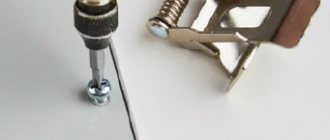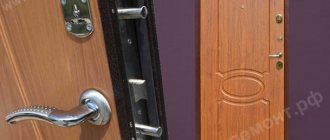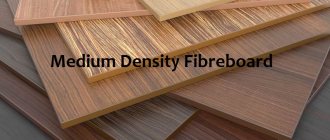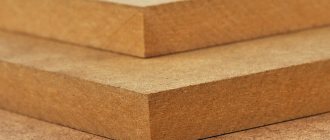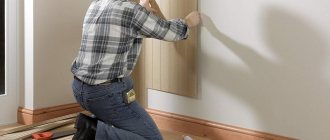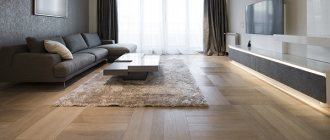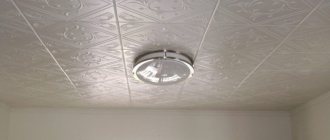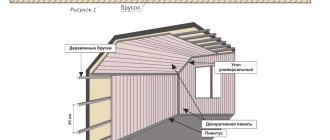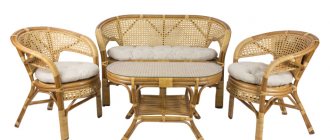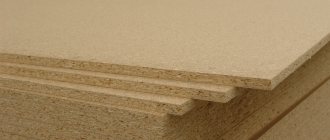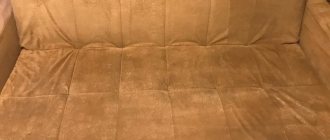Updated: 04/23/2021 12:51:21
Expert: Konstantin Borisovich Polyakov
The variety of modern finishing and construction materials means that choosing the right one can be very difficult. But you want furniture and interior elements to last a long time, be practical and safe. Therefore, the choice of materials must be taken with full responsibility.
Among the materials of wood origin, veneer and MDF are now the most common. Doors, interior partitions and cabinet furniture are made from them.
In this article we will figure out what the difference is between veneer and MDF - and which is better for use in certain conditions.
Veneer
Veneer is a woodworking product that is the most environmentally friendly and beautiful. That is why it is often used as a finishing material. For example, veneered interior doors are widespread on the market, which visually practically do not differ from those made of solid wood.
Veneer is obtained from logs. Thin shavings are cut from it in a whole sheet. The log is fixed in a special machine, a knife is placed along it, and then the “source” begins to rotate. The knife cuts a thin piece of wood called veneer.
That is why veneer preserves the wood texture and its natural shade. In the future, the sheets can be glued to each other - and then plywood is obtained. In addition, veneer of valuable wood species is used in furniture finishing - it can be covered with a “layer” of ebony, Karelian birch, rosewood, and so on.
In practice, veneer in its pure form is practically not used due to the small thickness of the sheet. It is either turned into plywood, or it is used to decorate decorative items and furniture. In rare cases, only musical instruments are made from blank sheets of thick veneer.
As a result, “veneered” doors and furniture are either made of plywood or simply covered with this material.
On the other hand, veneer is environmentally friendly. Even in the form of plywood, it does not have chemical compounds (resins, adhesives, paints) in contact with air. Therefore, veneered furniture can be installed in the kitchen and children's room. But it is not suitable for the bathroom - the material is very sensitive to high humidity and can begin to deteriorate under its influence.
So, let's summarize.
Advantages
- Attractive appearance, completely preserving the texture of solid wood;
- Environmentally friendly and safe, veneer does not emit harmful substances into the air;
- It can be made from valuable wood species while maintaining their visual and practical qualities.
Flaws
- Vulnerable to moisture;
- Does not participate in the air exchange process (air-tight and vapor-tight);
- Low qualities as a sound insulator;
- Plywood is extremely unstable to mechanical shocks and breaks and cracks easily.
Since veneer itself is practically not used in its pure form, when purchasing veneered furniture it is advisable to study what exactly is its basis and is used as a construction material - plywood, MDF, chipboard, fiberboard or other processing products.
Scope of application of the material
The scope of use of veneered products is quite extensive, but is limited to internal work:
- Full or partial wall finishing. The products fit well into any interior style, due to which the premises acquire comfort and coziness. Although the ceiling can also be covered with panels, this option is much less common.
- Creation of furniture facades. Veneered doors give a kitchen unit or wall an expensive look.
- Manufacturing of skirting boards and moldings. It is more difficult to glue veneer onto such parts, which affects their cost.
- Cladding of entrance or interior doors.
The range of uses for veneered MDF is quite wide, and the high-quality material can be installed in rooms with high humidity
Thus, veneered MDF is suitable for finishing all rooms of the house.
MDF
MDF (medium density fiberboard) is a wood processing product that is compressed chips. However, the production technology differs somewhat. Some MDF options involve “clean” pressing, without the addition of connecting substances. In other cases, wood shavings are mixed with urea resins.
The addition of urea resins not only increases the strength of MDF boards, but also makes it possible to impart some important performance properties to the material. For example, it may be fire-resistant, water-resistant, or resistant to biological hazards (mildew, mildew, pests).
The production method also affects operational parameters. For example, unimpregnated MDF has excellent air and vapor permeability. Therefore, interior doors made from it create a pleasant microclimate in the room and do not allow the air to stagnate. But at the same time their mechanical strength is extremely low. And this material is hygroscopic - it quickly absorbs moisture, turning into an excellent place for the development of fungi and mold.
Impregnated MDF, in which wood shavings are held together with resin under pressure, is free from the above disadvantages. It is strong, reliable and durable. Able to resist pests, fungus and mold. It is good to make furniture from impregnated MDF - it becomes stable and reliable. Moreover, the resin can make it waterproof - and then the table or chair can even be used in the bathroom. And, of course, it increases the mechanical strength of the material.
On the other hand, impregnation deprives MDF of air and vapor permeability. Therefore, it is not recommended to use it as a material for interior doors. If a room remains closed for a long time, the air in it will seem “stale.”
So, let's summarize.
Advantages
- Air and vapor permeability for unimpregnated;
- High strength, reliability and excellent performance characteristics of the impregnated material;
- Low price.
Flaws
- Low mechanical strength and hygroscopic properties of unimpregnated;
- Lack of air and vapor permeability in the impregnated product;
- Ugly appearance.
It is worth noting that MDF in its pure form is practically not used (except in the production of packaging and acoustic enclosures) - precisely because of its unattractive appearance. Even unimpregnated sheets are either laminated with polymer films that imitate the texture of wood or simply have some color, or are veneered.
Scope of application of the material
The scope of use of veneered products is quite extensive, but is limited to internal work:
- Full or partial wall finishing. The products fit well into any interior style, due to which the premises acquire comfort and coziness. Although the ceiling can also be covered with panels, this option is much less common.
- Creation of furniture facades. Veneered doors give a kitchen unit or wall an expensive look.
- Manufacturing of skirting boards and moldings. It is more difficult to glue veneer onto such parts, which affects their cost.
- Cladding of entrance or interior doors.
The range of uses for veneered MDF is quite wide, and the high-quality material can be installed in rooms with high humidity
Thus, veneered MDF is suitable for finishing all rooms of the house.
Which is better - veneer or MDF?
So, veneer is sheets of natural wood that are used as a finishing material in combination with some kind of base (or in further production they are turned into plywood), and MDF is boards made from chips that are good to use as a structural material.
However, the difference between the two materials is not limited to this.
| Characteristic | Veneer | MDF |
| The basis | Cut (peeled) wood sheets | Pressed sawdust with or without resin |
| Further use | Finishing or turning into plywood | Film lamination or veneering |
| Scope of use | Decorative purposes, plywood can be used to assemble structures | Manufacturing of cabinet furniture, wall and structural panels, laminate, containers, acoustic enclosures |
| Noise insulation | Average | Excellent |
| Vapor permeability | High | Impregnated is impenetrable, unimpregnated is permeable |
| Mechanical strength | Low | Low for unimpregnated, high for MDF with resin |
| Resistance to biological harmful factors | Average | Without impregnation, easily susceptible to mold |
So, the ideal solution is MDF coated with veneer. It combines the advantages of both materials.
Production technology
In the manufacture of MDF, both solid logs and waste from the woodworking industry are used.
- For the production of slabs, highly crushed sawdust is used, which is obtained by cutting pre-cleaned logs. The resulting fraction is cleaned of foreign inclusions, treated with hot steam and fed into the refiner.
- During the process, wood pulp releases a binding agent - lignin, which ensures good adhesion of the fibers. Depending on the quality of the source material, resins and paraffin are added to the mixture, and in some technologies a hardener is added.
- The resulting mass is sent for drying, where excess moisture is removed. Then a forming and pre-pressing process occurs, which removes air and creates a complete web.
- At the main stage, pressing, the thickness of the slab is adjusted to the required value, cut and left to cool.
- During the grinding process, the material acquires its final consumer appearance, unevenness and roughness are smoothed out, and if necessary, it is veneered, painted or laminated.
Sawdust is used to produce MDF.
For organizations
Attention to organizations accepting orders for the manufacture of kitchens, wardrobes, and other products from MDF, chipboard, plywood!
We offer you the production of furniture parts lined with veneer according to standard sizes for further processing (as well as according to customer dimensions, edges, painting according to the customer’s sample).
We produce large quantities of ready-to-install overlays for metal doors made of veneer and solid wood.
Various types of staining and varnishing.
Step-by-step instruction
Installation of sheets is glue-based and does not require much time. Cladding walls onto a frame is a more labor-intensive process, but even an inexperienced craftsman can handle it by following simple recommendations.
Preparatory activities
Before installation on the frame, a special structure must be installed. The lathing is made of a metal profile or wooden beam (side length 30 mm and humidity no more than 15%). Before installation, the wood is treated with a bioprotective impregnation.
To carry out the work you will need the following tools: tape measure, level, electric jigsaw or hacksaw, screwdriver, hammer or stapler.
To carry out the work you will need an electric jigsaw.
Installation of guides depends on the location of the panels. In the case of vertical installation, the sheathing elements are attached horizontally to the wall, i.e. perpendicular to the canvas. In other orientations, the installation is carried out in reverse.
Execution of work
Work order.
- Measuring and marking the wall (distance between guides 50-60 cm).
- Attaching the profile to the surface. The first rail is installed at the junction of 2 walls. It is attached to a concrete or brick surface using dowels, and to a wooden surface with self-tapping screws.
- Between the frame elements, additional wall insulation is made, for example, mineral wool is laid.
- The starting panel is mounted in a corner and secured with self-tapping screws to the guide. On the opposite side, clamps are inserted into the groove at the intersection with the slats and secured with nails or staples.
- The tenon of the next lining is driven into the groove of the previous one and fixed with clamps.
- The last sheet is cut so that it fits freely into the groove of the previous one and there is a gap of 5 mm to the wall. Complete the fixation with a self-tapping screw.
Preparatory work
To perform high-quality veneering you need to acquire:
- veneer and glue;
- ruler and paper for cutting out the template;
- plywood knife and veneer cutter;
- iron and syringe;
- with a wooden roller or iron.
Restoration should begin with the dismantling of fittings and decorative elements on furniture walls, doors or other products. The old coating, which has served its purpose, is removed with a spatula.
The surface must be carefully leveled, eliminating any defects with glue or putty . After complete drying, sand it with sandpaper.
Next, the facing material is prepared. Most often, sheet veneer is sold, which is rolled into a roll for ease of transportation. The sheet is placed on the table and moistened with water using a sponge.
Please note: it is not recommended to use scissors to cut parts of furniture or door upholstery, because they result in unevenness. In addition, cracks will soon appear on the finished products due to damage to the base.
Under each sheet you need to put soft paper (to absorb moisture) and plywood. Place a small press on top. This is clearly visible in the photo. Smooth sheets are cut into strips with a veneer cutter or plywood knife, in accordance with measurements.
For individuals
Attention to individuals who want to independently make a wardrobe or other furniture from veneer boards. Our workshop accepts orders for the production of various furniture parts according to your sizes.
Minimum thickness of the furniture panel base: 3 mm. Maximum thickness of the base sandwich: 60 mm (order is calculated individually).
For all questions, write to us at, or call the numbers indicated in the contacts;; (499) 553-81-73
You can also place an order by filling out the form on the website:
Material advantages
- Veneered MDF looks exactly like natural wood. And in strength and wear resistance, this material is completely superior to solid wood.
- The advantages of film-coated MDF also include resistance to moisture and temperature changes, durability and unpretentiousness.
- Unlike solid wood, which requires constant and careful care, the MDF surface needs only a little attention.
- Furniture made from particle boards weighs little, so the products are easy to transport and rearrange. MDF sets can survive several repairs and moves.
The production of veneered MDF has been put on stream, as the material is always in demand. Designers also love it for its wide range of possibilities, environmental friendliness and “noble” origin.
Installation of veneer panels on the wall
Wall panels in the interior
Attaching such panels to the wall is quite simple. This procedure can be carried out using the following methods:
- adhesive lining;
- frame;
- through rustics.
The simplest and most popular method of mounting panels is frame. With this option, a frame is initially created from wood or metal, onto which a veneer panel is subsequently attached using various means of hidden fixation. With this method, the usable area of the room is reduced.
Frame method of mounting panels on the wall
Interesting to know. The frame method is ideal for cases where the walls in the apartment are uneven. The costs of pre-leveling and wall treatment are eliminated.
If the wall surface is absolutely flat, without flaws or bumps, then sheets of veneered MDF boards can be fixed with a special adhesive composition.
Important! Before fixing the veneer panels, it is necessary to prepare the surface: remove dust, dirt, and grease.
If the panels have recesses and protrusions on the sides, then they can be secured using special guide strips - rustics.
Low cost, pattern and texture of natural wood, ease of installation and maintenance, wide range of applications indoors and outdoors - these are the qualities that veneered MDF panels have.
